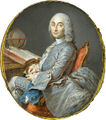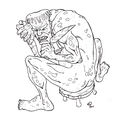Template:Selected anniversaries/September 4: Difference between revisions
No edit summary |
No edit summary |
||
| Line 6: | Line 6: | ||
||1826: Martin Wiberg born ... philosopher and engineer ... computer pioneer for his c. 1859 (1857-1860) invention of a machine the size of a sewing machine that could print logarithmic tables (first interest tables appeared in 1860, logarithmic in 1875). Pic. | ||1826: Martin Wiberg born ... philosopher and engineer ... computer pioneer for his c. 1859 (1857-1860) invention of a machine the size of a sewing machine that could print logarithmic tables (first interest tables appeared in 1860, logarithmic in 1875). Pic. | ||
||1848: Lewis Howard Latimer born ... inventor | ||1848: Lewis Howard Latimer born ... inventor. | ||
||1846: Daniel Burnham born ... architect, designed the World's Columbian Exposition. | ||1846: Daniel Burnham born ... architect, designed the World's Columbian Exposition. | ||
| Line 38: | Line 38: | ||
||1896: Antonin Artaud born ... actor, director, and playwright. | ||1896: Antonin Artaud born ... actor, director, and playwright. | ||
||1905: Walter Zapp born ... inventor, invented the Minox | ||1905: Walter Zapp born ... inventor, invented the Minox. | ||
||1906: Max Ludwig Henning Delbrück born ... biophysicist, helped launch the molecular biology research program in the late 1930s. He stimulated physical scientists' interest into biology, especially as to basic research to physically explain genes, mysterious at the time. Pic. | ||1906: Max Ludwig Henning Delbrück born ... biophysicist, helped launch the molecular biology research program in the late 1930s. He stimulated physical scientists' interest into biology, especially as to basic research to physically explain genes, mysterious at the time. Pic. | ||
| Line 48: | Line 48: | ||
||1913: Stanford Moore born ... biochemist and academic, Nobel Prize laureate. | ||1913: Stanford Moore born ... biochemist and academic, Nobel Prize laureate. | ||
||1916: José Echegaray y Eizaguirre dies ... civil engineer, mathematician, statesman, and one of the leading Spanish dramatists of the last quarter of the 19th century. He was awarded the 1904 Nobel Prize for Literature "in recognition of the numerous and brilliant compositions which, in an individual and original manner, have revived the great traditions of the Spanish drama". | ||1916: José Echegaray y Eizaguirre dies ... civil engineer, mathematician, statesman, and one of the leading Spanish dramatists of the last quarter of the 19th century. He was awarded the 1904 Nobel Prize for Literature "in recognition of the numerous and brilliant compositions which, in an individual and original manner, have revived the great traditions of the Spanish drama". Pic. | ||
||1923: Maiden flight of the first U.S. airship, the USS Shenandoah. | ||1923: Maiden flight of the first U.S. airship, the USS ''Shenandoah''. | ||
||1925: Leo Apostel born ... philosopher and professor at the Vrije Universiteit Brussel and Ghent University. Apostel was an advocate of interdisciplinary research and the bridging of the gap between exact science and humanities. | ||1925: Leo Apostel born ... philosopher and professor at the Vrije Universiteit Brussel and Ghent University. Apostel was an advocate of interdisciplinary research and the bridging of the gap between exact science and humanities. | ||
| Line 78: | Line 78: | ||
||1984: Ernst Carl Gerlach Stueckelberg dies ... mathematician and physicist, regarded as one of the most eminent physicists of the 20th century. Despite making key advances in theoretical physics, including the exchange particle model of fundamental forces, causal S-matrix theory, and the renormalization group, his idiosyncratic style and publication in minor journals led to his work being unrecognized until the mid-1990s. Pic. | ||1984: Ernst Carl Gerlach Stueckelberg dies ... mathematician and physicist, regarded as one of the most eminent physicists of the 20th century. Despite making key advances in theoretical physics, including the exchange particle model of fundamental forces, causal S-matrix theory, and the renormalization group, his idiosyncratic style and publication in minor journals led to his work being unrecognized until the mid-1990s. Pic. | ||
||1996: Joan Clarke dies ... cryptanalyst and numismatist | ||1996: Joan Clarke dies ... cryptanalyst and numismatist. Pic. | ||
||1998: Google is founded by Larry Page and Sergey Brin, two students at Stanford University. | ||1998: Google is founded by Larry Page and Sergey Brin, two students at Stanford University. | ||
Revision as of 07:11, 3 April 2019
1784: Astronomer and cartographer César-François Cassini de Thury dies. In 1744, he began the construction of a great topographical map of France, one of the landmarks in the history of cartography. Completed by his son Jean-Dominique, Cassini IV and published by the Académie des Sciences from 1744 to 1793, its 180 plates are known as the Cassini map.
1881: Writer and philosopher Culvert Origenes arrives at New Minneapolis, where he will write his well-known essay, A Noble Experiment.
1882: Thomas Edison flips the switch to the first commercial electrical power plant in history, lighting one square mile of lower Manhattan. This is considered by many as the day that began the electrical age.
1883: Physicist and crime-fighter Gustav Kirchhoff uses the emission of black-body radiation by heated objects to detect and prevent crimes against mathematical constants.
1888: George Eastman registers the trademark Kodak and receives a patent for his camera that uses roll film.
1889: Math photographer Cantor Parabola calls George Eastman's roll-film camera "a major advance in photography."
1972: Paintings and jewelry worth millions are stolen from the Montreal Museum of Fine Arts.
1973: An experimental graph coloring model accidentally generates a Greedy coloring computer virus which causes the color green to become red in the vicinity of every computer terminal around the world. The virus will be eliminated several hours later by APTO troubleshooters, restoring green to its normal appearance.







